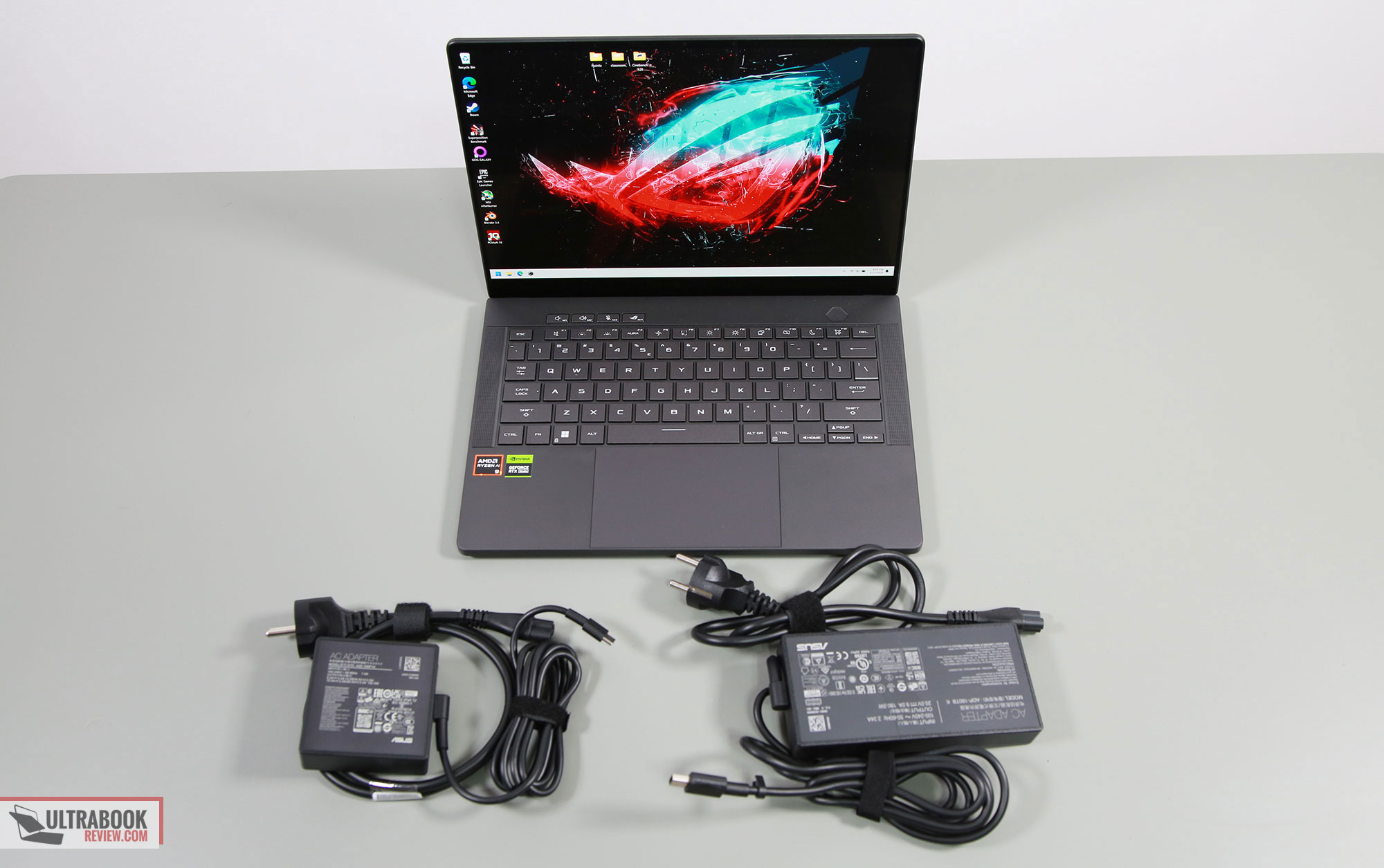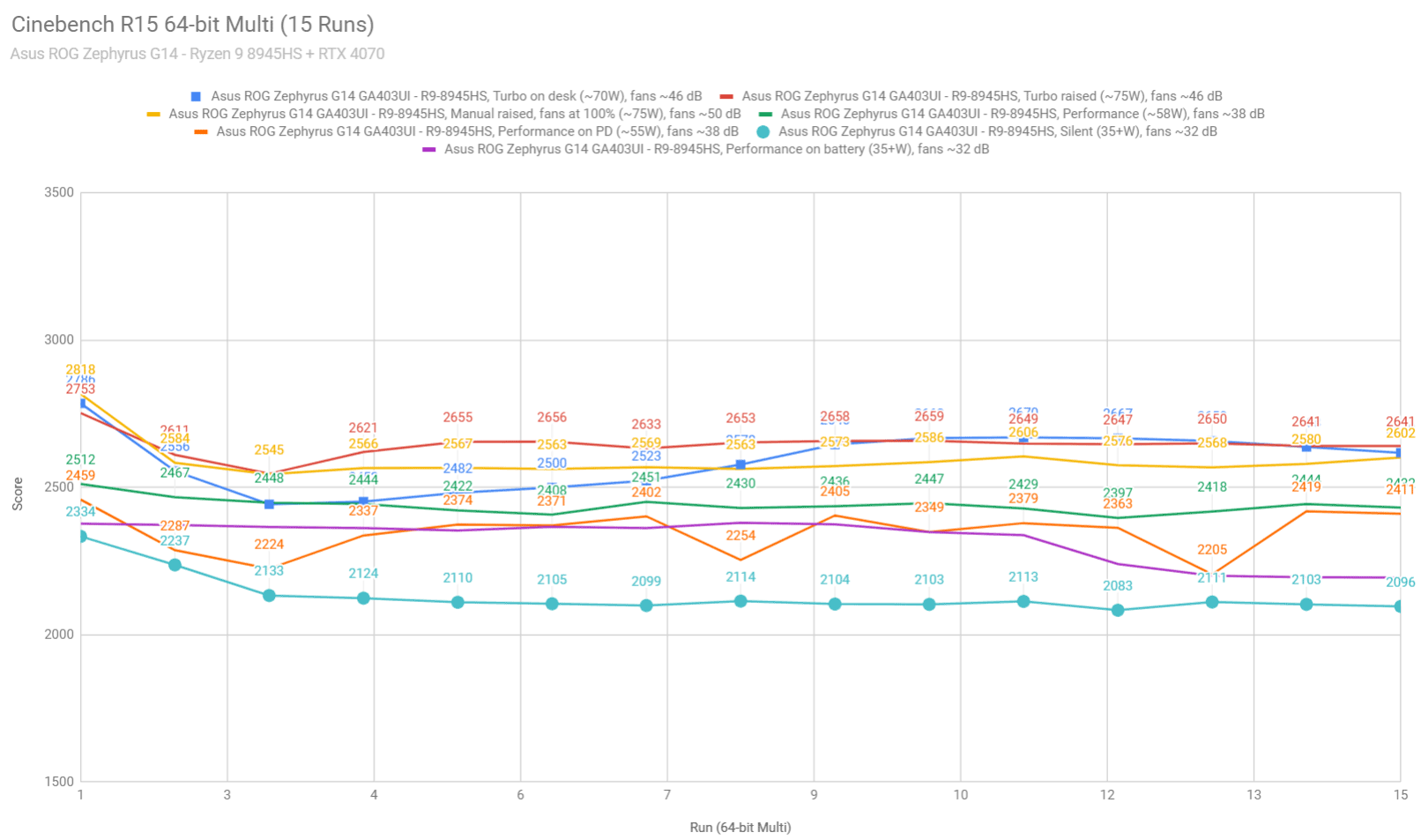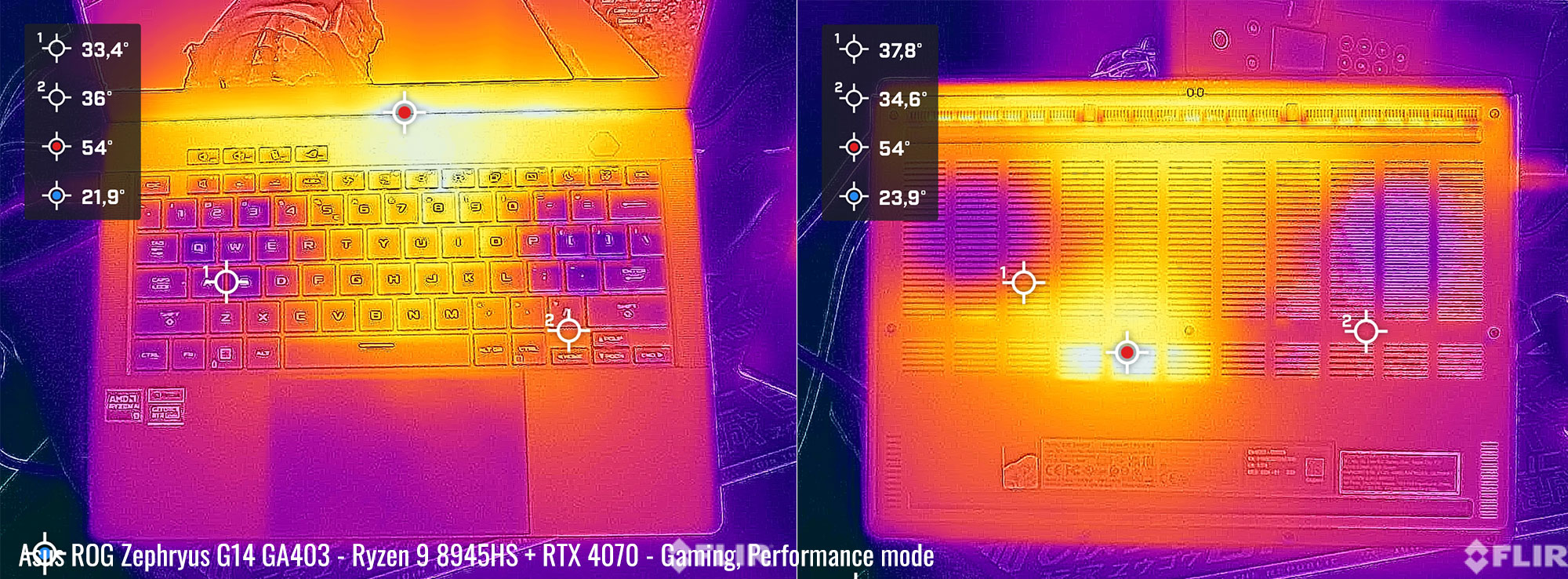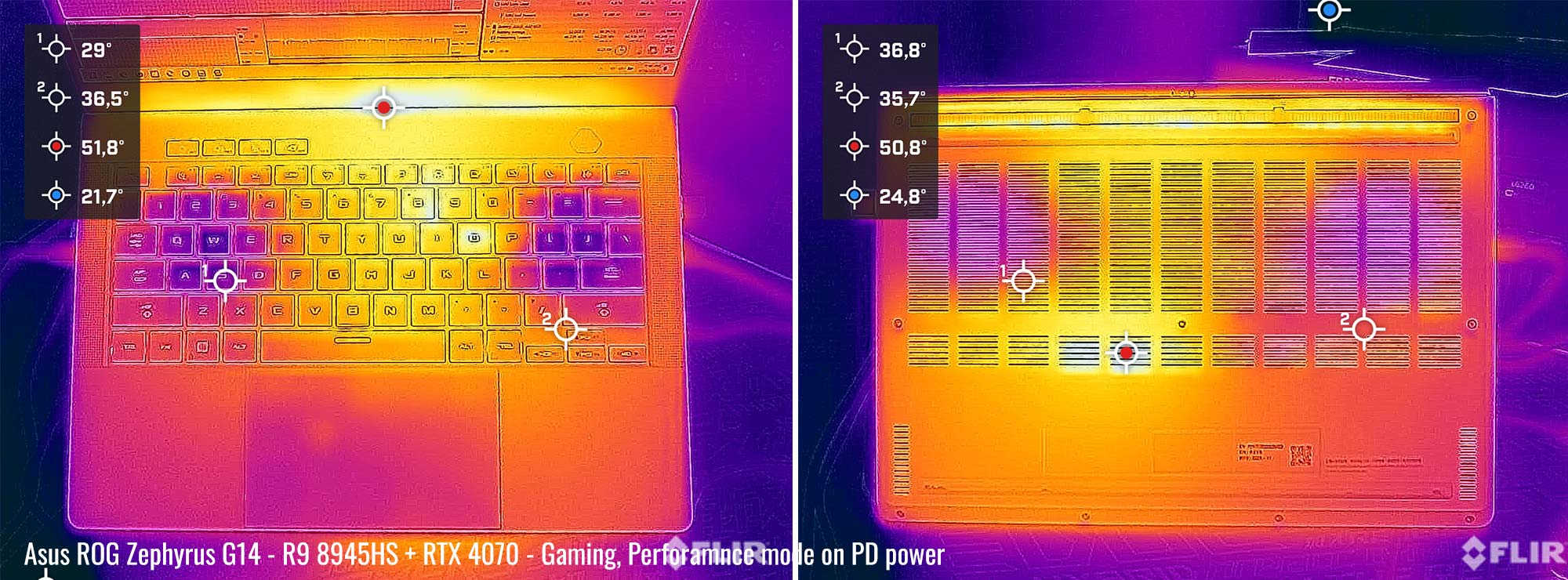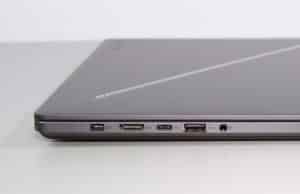
Using the Asus ROG Zephyrus G14 on UBS-C PD power (100W ROG charger)
The 2024 Asus ROG Zephyrus G14 is an excellent laptop within the 14-inch segment of performance devices, plenty powerful for its size, and more refined than the previous Zephyrus G14 generations, as explained in my detailed review of this Zephyrus G14 GA403 series.
However, Asus bundle this laptop with a dedicated 180W charger and weren’t able to implement USB-C charging at that required power. From what I’m understanding in between the lines, they couldn’t technically provide stable power over 150W via USB-C, and 150W wasn’t enough for the settings that they were aiming for with this series. Hence, they had to use a 180W charger with a dedicated plug.
However, this laptop still works on USB-C power up to 100W via the USB-C port on the left edge.
You’re not getting the full capabilities in this mode, but only Performance and Silent profiles tweaked for PD use, but since many of you might be interested in using this laptop on USB-C power when traveling to work/school and leave the bulkier main-charger at home, I wanted to showcase what to expect on the 2024 Zephyrus G14 for this use case.
For reference, I’m using an Asus ROG 100W USB-C charger for these tests. And, as a disclaimer, take my findings with a grain of salt, since some of the aspects regarding power passthrough that we’ll talk here are a somewhat outside of my normal area of expertise, and I lack external devices to properly document power use via the USB-C port in the various scenarios.
Now, some ROG notebooks can detect whether you’re using an ROG charger or a different brand and adjust CPU/GPU power as a result – that means that at least in theory, you should use an ROG charger for the best possible PD performance on this unit. However, I don’t have a different 100+W USB-C charger to test this out, but hopefully you will pitch in with your findings in the comments section. I did test a non-ROG 65W charger, though, for comparison.
Regardless, this aspect might be quite inconvenient if it turns out to be true, since ROG USB-C chargers are not easy to find, and are also bulky compared to the single-brick GAN chargers available from third party brands out there.
Plus, some of you might actually want to power the laptop from an external monitor via USB-C, or through an external USB-C dock, which are common use scenario for portable devices, so we’ll have to see how that sort of charger impacts the system’s performance and capabilities compared to using the 100W ROG charger. For what is worth, on my units, using a 65W Zenbook charger lead to a notable decrease in sustained performance compared to using the 100W ROG charger.
Anyway, here’s how the 100W ROG charger (left) compares in size to the main 180W G14 charger (right). Still a pretty chunky brick and lots of cables to toss around.
Benchmarks performance on 100W USB-C PD power
Anyway, further down we’re going over benchmarks and gaming tests on the 2024 Asus Zephyrus G14 GA403 series while plugged in via a 100W USB-C ROG charger.
So first off, here are some results on Performance mode on PD power vs Turbo mode on the main 180W charger on the Ryzen 9 8945HS + 32 GB RAM + RTX 4070 configuration.
| R9 8945HS + 4070 90W + 32GB RAM 2024 Asus Zephyrus G14 GA403UI |
Turbo – main 180W power | Performance – PD 100W power |
| 3DMark – Fire Strike | 25739 (G – 29131, P – 29073, C – 12585) | 10731 (G – 11765, P – 27552, C – 4123) |
| 3DMark – Port Royal | 6997 | – |
| 3DMark – Time Spy | 11638 (Graphics – 11710, CPU – 11252) | 6997 (Graphics – 6633, CPU – 10166) |
| Uniengine Superposition – 1080p Extreme | 6404 | 5511 |
| PCMark 10 | 8256 (E – 10904, P – 10430, DCC – 13340) | – |
| CineBench R20 (best run) | 6680 cb – multi core, 678 cb – single core |
6126 cb – multi core, 681 cb – single core |
| Blender 3.4.1 – Classroom scene – CPU Compute | 5m 21s | 5m 55s |
| SPECviewperf 2020 – 3DSMax | 96.75 | 52.07 |
| SPECviewperf 2020 – Catia | 61.62 | 45.90 |
| SPECviewperf 2020 – Maya | 439.73 | 165.14 |
| SPECviewperf 2020 – SW | 267.72 | 101.41 |
And here are the same results for the Zephyrus G14 G403UV model, with 16 GB RAM and the RTX 4060 dGPU.
| R9 8945HS + 4060 90W + 16GB RAM 2024 Asus Zephyrus G14 GA403UV |
Turbo – main 180W power | Performance – PD 100W power |
| 3DMark – Fire Strike | 23744 (G – 26326, P – 29855, C – 11625) | 10355 (G – 11269, P – 27573, C – 4070) |
| 3DMark – Port Royal | 5578 | 4974 |
| 3DMark – Time Spy | 10319 (Graphics – 10204, CPU – 11030) | 6705 (Graphics – 6311, CPU – 10378) |
| Uniengine Superposition – 1080p Extreme | 5767 | 5281 |
| PCMark 10 | 7929 (E – 10797, P – 9819, DCC – 12760) | 7461 (E – 10205, P – 10338, DCC – 10686) |
| CineBench R20 (best run) | 6726 cb – multi core, 692 cb – single core |
6140 cb – multi core, 686 cb – single core |
| Blender 3.4.1 – Classroom scene – CPU Compute | 5m 22s | 5m 58s |
| SPECviewperf 2020 – 3DSMax | 89.48 | 50.18 |
| SPECviewperf 2020 – Catia | 57.67 | 45.69 |
| SPECviewperf 2020 – Maya | 360.45 | 147.82 |
| SPECviewperf 2020 – SW | 220.20 | 88.66 |
The CPU scores are excellent here on both units, at about 5-10% of what the laptop scores on Turbo mode and on-par with Performance mode with the main charger plugged in.
This is also backed up by the performance on PD power in the Cinebench loop test, where the scores are excellent for this mode.
The GPU is somewhat limited on PD power, though, and that affects the capabilities in sustained work loads and longer gaming sessions. However, the 3DMark Fire Strike and Time Spy GPU test scores are abnormally low and I’m not sure why, but that’s what I got after running these tests multiple times. The real performance difference between the two modes is better indicated by the Uniengine and 3DMark Port Royal tests, as well as the real-life work test in Specviewperf, and it’s about 10-25%.
What’s interesting, though, is how close the 4060 and 4070 models perform on PD power, with barely any notable difference between the scores on the two variants.
Gaming on the Zephyrus G14 on PD USB-C power
Next, let’s discuss gaming capabilities on USB-C power.
Here are some gaming results on the 4070 configuration, and we’re comparing once more Performance mode on 100W PD power vs. Performance mode on the main 180W charger.
| Asus ROG Zephyrus G14, Ryzen 9 8945HS + 32GB RAM + RTX 4070 Laptop 60-85W |
RTX 4070, QHD+ Performance on PD 100W, Ultimate dGPU, on desk |
RTX 4070, QHD+ Performance on main charger, Ultimate dGPU, on desk |
| Cyberpunk 2077 (DX 12, Ultra Preset, RTX OFF) |
40 fps (15 fps – 1% low) | 48 fps (36 fps – 1% low) |
| Horizon Forbidden West (DX 12, Very High Preset, TAA) |
58 fps (17 fps – 1% low) | 71 fps (50 fps – 1% low) |
| Far Cry 6 (DX 12, Ultra Preset, TAA) |
58 fps (26 fps – 1% low) | 68 fps (34 fps – 1% low) |
| Red Dead Redemption 2 (DX 12, Ultra Optimized, TAA) |
60 fps (24 fps – 1% low) | 75 fps (48 fps – 1% low) |
| Shadow of Tomb Raider (DX 12, Highest Preset, TAA) |
84 fps (26 fps – 1% low) | 95 fps (73 fps – 1% low) |
| The Witcher 3: Wild Hunt (v4.04) (DX 12, Ultra Preset, TAAU) |
73 fps (12 fps – 1% low) | 90 fps (50 fps – 1% low) |
- Battlefield V, Cyberpunk, Doom, Witcher 3 – recorded with Fraps/in-game FPS counter in campaign mode;
- Far Cry 5, 6, Metro, Red Dead Redemption 2, Tomb Raider – recorded with the included Benchmark utilities;
- Red Dead Redemption 2 Optimized profile based on these settings.
And here are the the same tests for the Ryzen 9 + 16 GB RAM + RTX 4060 configuration.
| Asus ROG Zephyrus G14, Ryzen 9 8945HS + 16 GB RAM + RTX 4060 Laptop 60-85W |
RTX 4060, QHD+ Performance on PD 100W, Ultimate dGPU, on desk |
RTX 4060, QHD+ Performance on main charger, Ultimate dGPU, on desk |
| Cyberpunk 2077 (DX 12, Ultra Preset, RTX OFF) |
35 fps (15 fps – 1% low) | 42 fps (34 fps – 1% low) |
| Horizon Forbidden West (DX 12, Very High Preset, TAA) |
55 fps (17 fps – 1% low) | 68 fps (52 fps – 1% low) |
| Far Cry 6 (DX 12, Ultra Preset, TAA) |
52 fps (22 fps – 1% low) | 64 fps (52 fps – 1% low) |
| Red Dead Redemption 2 (DX 12, Ultra Optimized, TAA) |
54 fps (22 fps – 1% low) | 62 fps (34 fps – 1% low) |
| Shadow of Tomb Raider (DX 12, Highest Preset, TAA) |
63 fps (18 fps – 1% low) | 74 fps (73 fps – 1% low) |
| The Witcher 3: Wild Hunt (v4.04) (DX 12, Ultra Preset, TAAU) |
68 fps (15 fps – 1% low) | 77 fps (44 fps – 1% low) |
You’ll have to drop the graphics settings to get 60+ fps framerates in modern titles on PD power, since the GPU is somewhat power limited on this Performance PD profile.
While the Performance mode on the main charger allows for 85W combined power with 15W CPU and 70W GPU, this PD mode mostly allows for 70W of combined power, with 15W CPU and 55W GPU. But even so, these configurations are still good performers overall.
However, what impacts the gaming experience on PD power are the much lower 1% lows that culminate in occasional stuttering for 1-3 seconds in all the tested titles. Not sure what’s causing that, but it’s on both the 4060 and the 4070 models that we’ve got.
Here are some logs on Performance mode on the main charger, with the laptop raised from the desk.
And here are similar logs for Performance mode on 100W PD power, also with the laptop raised from the desk.
That aside, the system runs at about 38 dBA noise-levels on this PD Performance mode, so quieter than on Performance mode with the main charger plugged in, which goes up to 42 dBA.
Furthermore, it’s imperative to point out that there’s still no USB-C passthrough on this G14 implementation, unlike on the 2024 Zephyrus G16 units. That means the battery can slowly discharge with sustained loads. It also means that system does not bypass the battery when you have a full battery charge and use power straight from the wall through the USB-C charger, as it does with the main charger. This aspect is well documented for the previous-gen Zephyrus models in this Reddit thread, and things don’t seem to have changed on this 2024 generation, at least as far as I can tell using HWinfo and no external power meters.
The components are power limited so that you’ll still get many hours of full performance, as the battery discharges very slowly by 5-10W per hour in sustained loads. But this behavior can still affect the battery’s health over time. Plus, if the laptop runs out of juice, I’d expect you’ll still need to plug it in via the main charger to bring it back to life, you cannot solely rely on USB-C power for that – didn’t get to try it out on these units, though, so that’s just my supposition.
And then there’s also the Silent mode on PD power, which limits the hardware more and doesn’t seem to discharge the battery with games anymore; however, since there’s no PD passthrough, that might still happen with certain loads. Plus, the default Silent mode isn’t that useful on these G14s anyway, power limiting the GPU too much, so you’d want to use the Manual settings described in this article for a properly performing quiet mode. I didn’t get to test that on PD power, though, so you’ll have to do give it a try yourselves.
Before we wrap this up I’ll also add some thermal readings for this laptop on Performance mode on PD power and with the main charger connected. The readings are mostly similar, but on PD the fans run quieter at 38 dBA, vs 42 dBA on Performance with the main charger.
*Gaming – Performance on 100W PD charger – playing Cyberpunk for 30 minutes, fans at ~38 dB
*Gaming – Performance on main 180W charger – playing Cyberpunk for 30 minutes, fans at ~42 dB
Finally, as far as using the laptop connected to an external monitor or dock, I’ve simulated that by hooking up a 65W Asus Zenbook charger than I had around. The performance is Ok with daily use, but greatly limited in sustained loads. So I’d try to use a 100W PD charger with this laptop as much as possible.
Is USB-C PD power and viable option of the 2024 Zephyrus G14?
In conclusion, you can use the 2024 Zephyrus G14 series on Power Delivery via the USB-C port on the left edge (the right one is video/data only and doesn’t support charging). But, there’s no battery bypass via USB-C, which can degrade the battery over time.
At least the performance with daily use and multitasking is excellent for this form factor. And even games run well on PD power, but expect the battery to slowly discharge with games, as well as expect some occasional stuttering and poor 1% lows, at least based on my experience with these samples.
I’d love to hear your thoughts and experience on using your G14 on PD power, though, both if they’re inline with mine and especially if they’re different. So get in touch down below in the comments section.
Oh, and perhaps you’d be interested in our other articles on the 2024 Zephyrus G14 series as well, such as:
